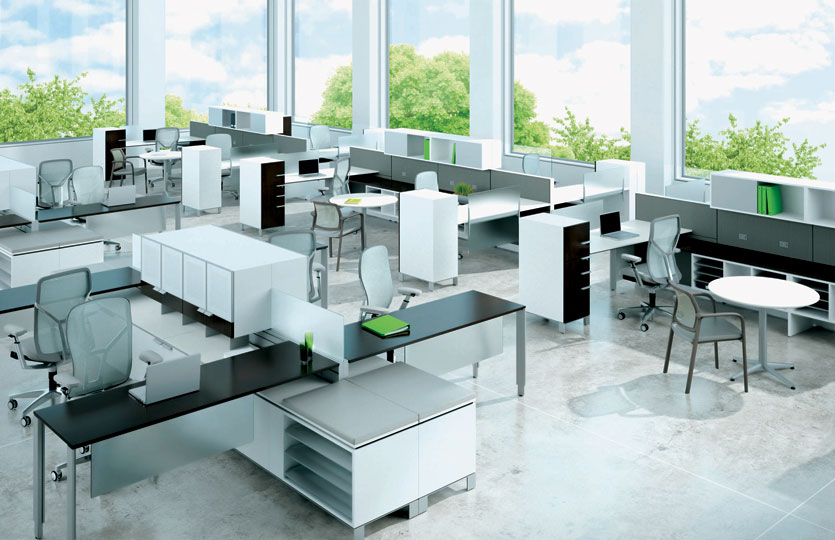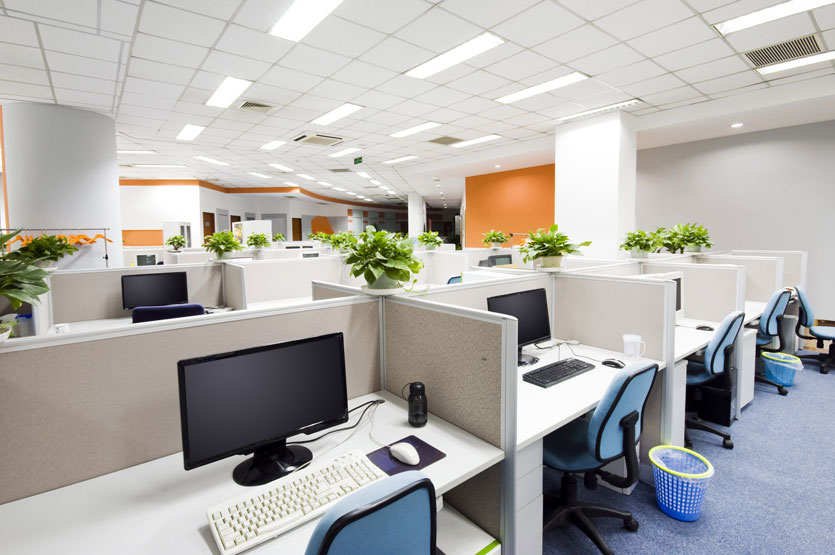Dec 16 2016.
views 845Is open plan the next big thing in Sri Lanka?
If you’re not familiar with the term ‘open space’ or ‘open plan’ concept, then think of the headquarters of Google, Pixar or Facebook. Imagine a vast open space equipped with several workstations featuring state-of-the-art furniture, minimal dividers, aesthetic interior designs and a comfortable working environment.

Open plan is one of the many different types of work floor plans or arrangements practiced in the contemporary business world.
Whether it is a large conglomerate or a small business office tucked in a corner of a shopping mall, all office spaces necessarily include one or more of the following categories.
Types of workspace
The concept of open-plan was first introduced in the early 20th century by an Industrial Engineer Frederick Winslow Taylor, in an attempt to boost efficiency in factories. The idea was to split the expansive factory space by long rows of desks to efficiently position assembly line workers – shoulder to shoulder - and streamline the work.

However, during the mid 20th century cubicles were introduced, transforming the long rows of desks into clusters of personalized spaces. The opaque or translucent partitions rising barely above the heads of a seated worker, returned the much desired privacy that was deprived in the open plan.
As work floor plans evolved, a prominent gap was observed between the management at the top and the employees at the bottom of a hierarchy. Those at the top occupied comfortable office rooms, while those from mid to low levels occupied shared offices or cubicles.
However, with the emergence of mobile technology in late 20th century, the open plan concept resurfaced, albeit in a more sophisticated and modern manner.
According to studies and surveys conducted by various institutes including the Queensland University of Technology in Australia, the open plan concept has both advantages and disadvantages, where the latter was more prominent than the former.
Pros
Cons

According to writer, PR and social media Consultant Ajita Kadirgamar, open plan concept is not entirely new to the island.
She stated that the plan was observed in the offices of the public sector a few decades ago, where it was a common to see large rooms equipped with wooden desks and stiff wooden chairs.
Constrains on privacy and focus
“You spend nine to 12 hours a day in an office. While it’s important to interact with your colleagues, you also need to focus on your work,” she said, stressing on the importance of privacy and focus while comparing the cubicle layout against the open plan.
She also elaborated that cubicles added a sense of personalised space, where each person had the liberty to decorate their limited space with potted plants or by pinning photos of families.
When enquired about his experience of working in an open plan layout, an employee of YAMU highlighted its drawbacks.
“It's pretty noisy and hard to concentrate at times, but it is the economic factors that keep us from putting up partitioning at this point.”

Growth in team-oriented work
However, contrary to this view, a Human Resources Manager attached to a leading BPM (Business Process Management) company in Colombo expressed her views highlighting the advantages of the open plan concept.
“Being a BPO (business process outsourcing) firm, the open plan layout facilitates easy approach to the staff, better communication and information sharing. It also helps to foster high team spirit and offers the convenience of quick team huddles.”
She also stated that the high energy level and achievements of one team often motivated the other teams, adding that she does not find any negative traits in a BPO environment.
Open plan concept is not only limited to industries like BPO.
Suwan Fernando, a Senior Executive in a leading Telecommunications firm in Colombo agreed on the benefits of open space, stressing that it also helps to boost efficiency.
According to Suwan, his office was converted to an open space plan only less than a year ago, but the firm is already reaping benefits.
“Coordinating with peers became more efficient, and all team members developed better understanding on the other person’s work,” he said.
He also emphasized that the new layout improved team bonding and facilitated easy monitoring of the staff.
However, he also mentioned that the level of noise is definitely an issue observed in such an environment.
Nevertheless, Suwan remained positive that the open plan works well in firms that can afford ample space, and added that it may not be ideal in an environment where employees are required to handle frequent calls.
Hierarchical perspective: Partition Vs No-partition
News Presenter Sasanka Dias brought light to a different perspective on the subject.
“If you take Facebook office, Mark Zuckerberg and his team are working on the same platform, in one expansive hall. There are no hierarchical differences between the employer and the employees.”
However, in relation to the context of Sri Lanka, he added that Sri Lankans tend to give more prominence to hierarchical structures, while those in other parts of the world focus more on the ultimate outcome.
“Having no partitions definitely makes it easier to collaborate with your colleagues and enhance team spirit. But on the contrary, this sort of environment deprives employees’ privacy while interruptions will be inevitable.”
Office space for next generation
In response to this matter, Ajita Kadirgamar recalled her experience at an office in California, USA where she came across a workspace shared by different individuals from different companies.
“I could hear different conversations and it caused lot of distractions. But we had no way of blocking the noise out.”
In this sophisticated open plan concept, different individuals or companies had the privilege of hiring sections of a common workspace as per their requirements.
She also added that the new plan allows people, who usually work from home, to reserve temporary workspaces so that they can carry out their work, hold discussions or meetings. She further stressed that this new trend is currently emerging in Sri Lanka as well.
Effects on individual performance
On December 30th 2014 the Washington Post published an article titled “Google got it wrong: The open-office trend is destroying the workplace”.
According to the article, about 70 percent of U.S. offices have no or low partitions and the concept has already been embraced by the Google, Yahoo, eBay as well as the American Express.
Quoting the Journal of Environmental Psychology, a study conducted in 2013, the article further stated that many workers in open space offices are frustrated by distractions, which leads to poor work performance. It also noted that nearly half of the surveyed workers accepted that they were significantly affected by the lack of privacy.
Is this concept suitable for a country like ours?
News Presenter Sasanka Dias threw light upon the matter from a different perspective.
Highlighting on the work ethics and attitudes of the employees of public and private sectors, he stated that the concept may not suit some of the public sector offices, where it is prone to have idle chatter.
“In my view, it will be difficult to impose changes in government offices in Sri Lanka in particular, as people normally resist change,” he said.
On the other hand, he showed that private sector firms normally expect strict work discipline and ethics from their employees, consequently minimizing time wastage and demanding focus.
A senior academic from a state university in Colombo highlighted the importance of a conventional office layout, where there are partitions and separate office rooms, providing more privacy and ability to focus.
She also noted that team spirit and collaboration does not lack in such environments, as they facilitate meeting rooms to share views and improve interaction.
Is Sri Lanka ready to embrace open plan?
Elaborating on the drawbacks of open plan, she noted that it’s important to understand matters from a cultural and employees’ perspective.
“I don’t think open plan concept is ideal for a country like Sri Lanka, be it public or private sector. But it may suit specific professions, for example in a construction field - you can place a group of engineers and architects in an open plan setting.”
She also stressed that it’s important to find out if the employees are comfortable with the plan.
“If they are compelled to work in an environment affected by noise, lack of concentration and privacy, it will hinder their performance, and affect productivity in due course.”
Currently there are valid arguments being pointed out by various factions in the world against the open plan concept, as to how it negatively affects companies that require less collaboration and more individual focus.
They also point out distractions, frequent illnesses, and decline of performance as some of the negative implications of open plan.
Nevertheless, it will be ideal for the employers of various industries to consider adapting the open plan, instead of adopting it as a whole. Adapting the concept will leave provision to redesign the floor plan as per the company as well as employee requirements.
This in turn will ensure a win-win state for both the employer and the employee, boosting job satisfaction, individual performance, better efficiency and higher productivity.
Text by Ganga Ratnayake
0 Comments